If you own a mid-century modern home, you probably know a bit about the architectural style and its key characteristics. A rising suburban star from the mid-40s to the late 60s, when the end of World War II brought prosperity and a renewed interest in spending leisure time outdoors, the mid-century modern home was quite different from its European-influenced predecessors.
With wide, low-slung profiles, muted color palettes, and natural construction materials, mid-century modern design marked the joining of home and landscape. No longer was the garden strictly ornamental or functional. It was a place to relax and entertain, an extension of the house itself.
Restrained in both color palette and plant choice, the mid-century modern garden achieves simplicity and symmetry through clean bed lines and repetitive patterns. It features regionally appropriate plants. They are carefully chosen to respect the land on which the home was built and create garden ‘rooms’ to link inside and out. It favors texture over riotous color and opts for low-maintenance materials so life can be enjoyed.
If you’re designing or reviving a mid-century modern home garden, these principles can help you make choices appropriate to the architecture. Plant selections will vary according to region, but we’ve come up with a list of 25 trees, shrubs, and flowers that resonate well with the home style. Read on for a look at their unique characteristics and growing requirements.
Pagoda Dogwood
With a wide, horizontal branch structure, attractive bark, and a relatively modest height, pagoda dogwood looks perfectly at home in the mid-century modern garden. A profusion of simple, four-lobed flowers appears in early spring before most trees leaf out.
The petals are white to pink in color and lend themselves well to a calm overall palette. Clusters of red berries provide late-season interest and encourage visits from the local fauna. Plant one to anchor a walkway or two to frame the front porch.
Japanese Maple
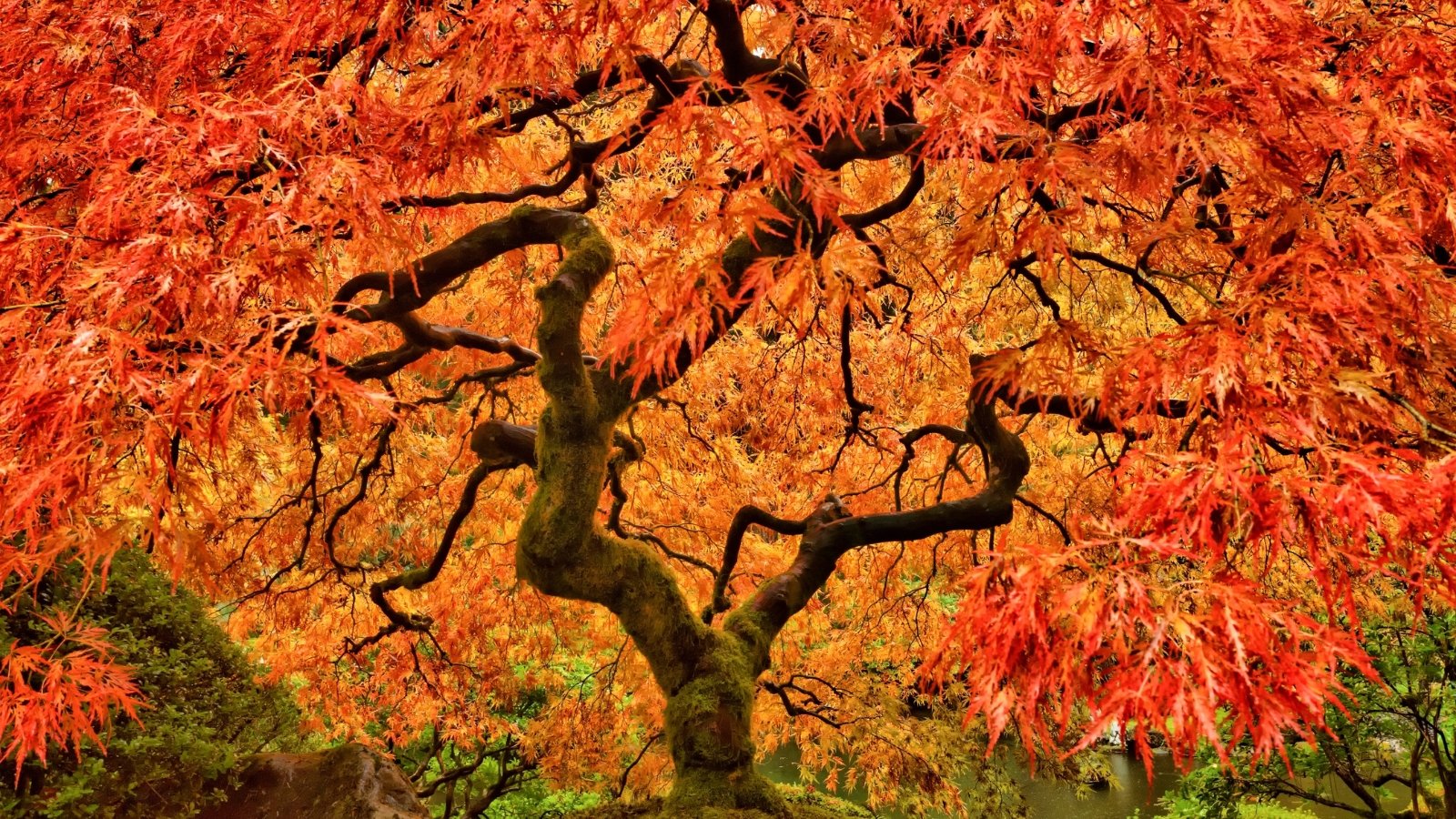
Another small tree with a horizontal branching habit, Japanese maple is an understory plant that brings muted color to the landscape. ‘Bloodgood’ is a mid-century modern garden favorite for its rich, dark burgundy leaves, while ‘Koto Ito Kamachi’ is prized for its feathery leaves and vivid green-orange color.
Japanese tree maple handles pruning well and provides a layered effect that resonates with a mid-century home’s low-slung facade.
Blue Rug Juniper
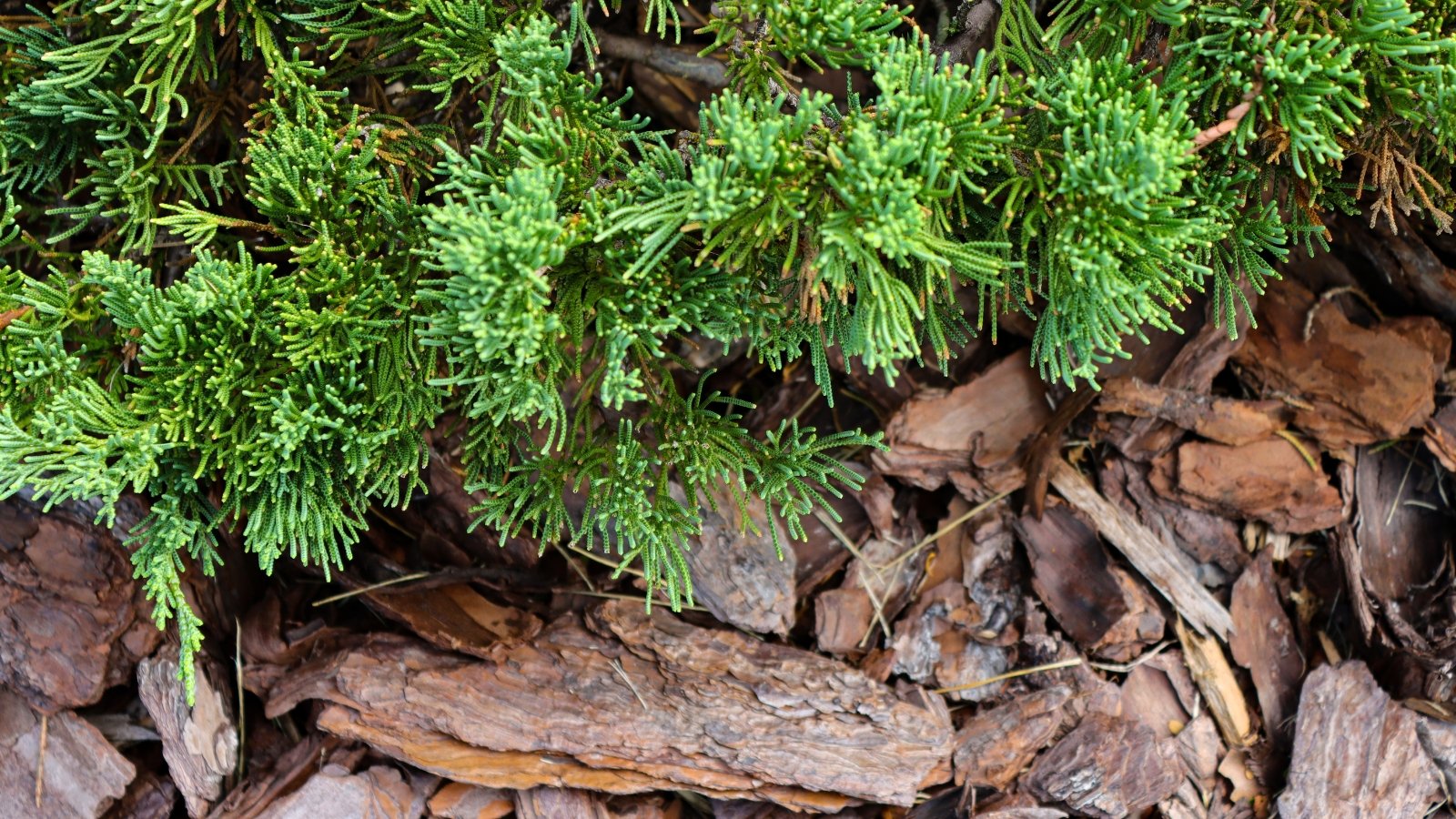
This low-growing evergreen creeper has a max height of six inches and a spread of four to six feet. It adapts well to varying soil conditions and tolerates wild fluctuations in temperature.
Like its vertical juniper relatives, blue rug has attractive blue-green needles, grayish berries, and a light scent. It is often used as a ground cover in mid-century design, filling a geometric bed section or spilling over a terraced flagstone retaining wall.
Boxwood
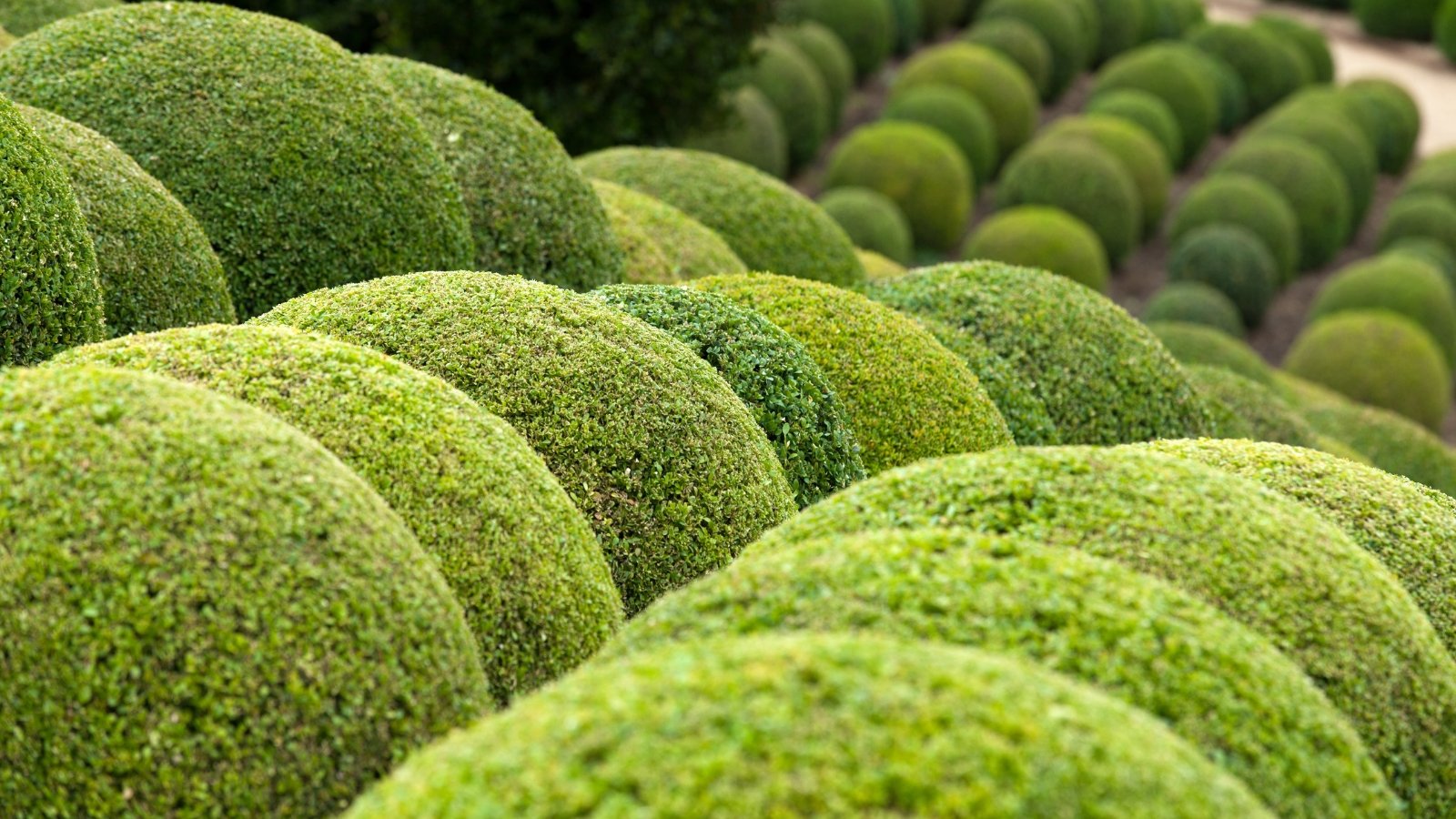
Easily clipped into a ball or square, boxwood shrubs are a staple in mid-century modern garden design. A neat row of orb-shaped ‘green gem’ boxwoods below a living room picture window provides a nice geometric offset to a massive pane of glass.
A span of squared-off ‘baby jade’ boxwood lining the front walkway serves as a low extension of the home’s architectural form.
Yew
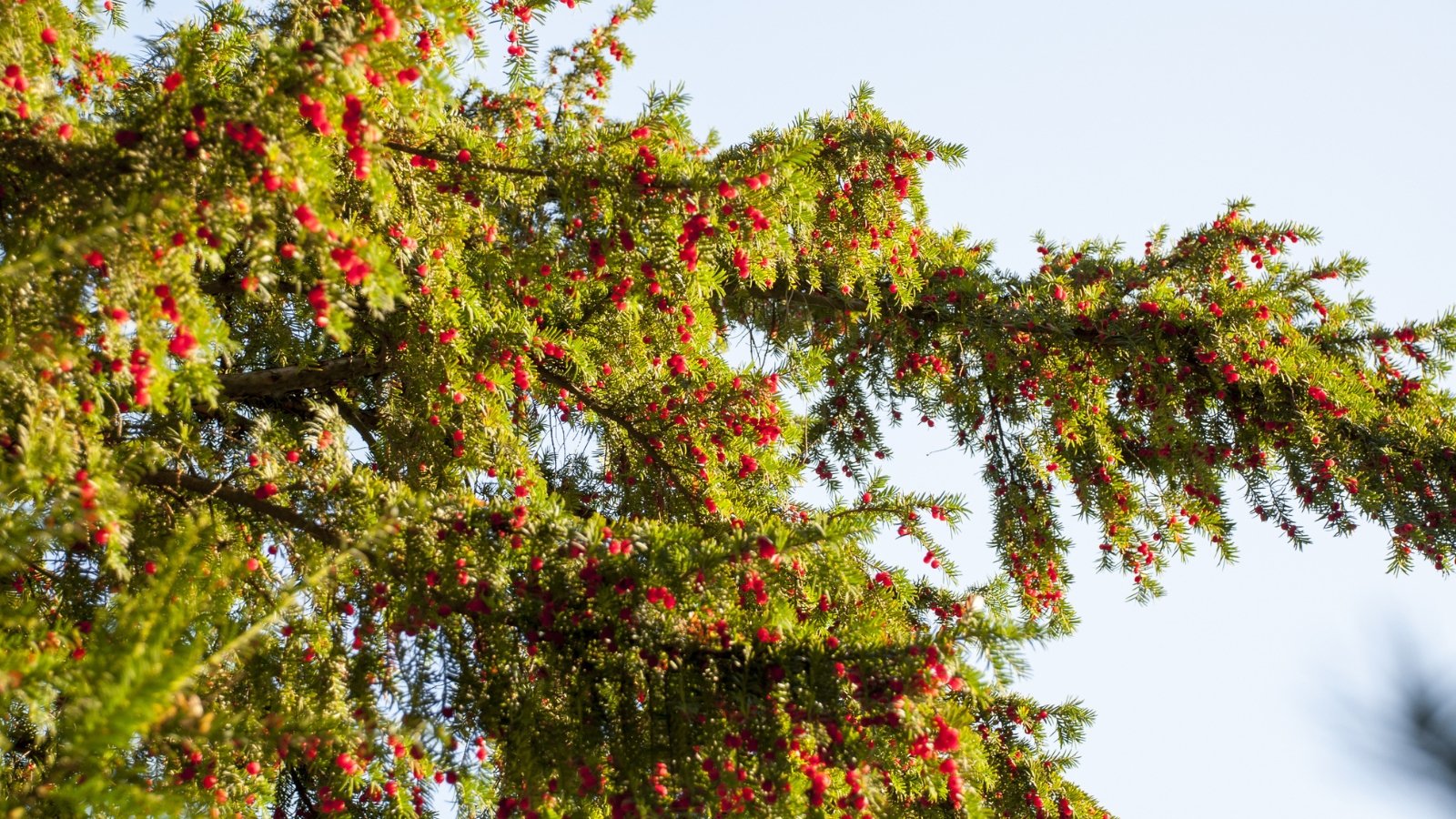
A great choice for yards with shade or northern exposure, yew is a brighter, softer evergreen option for the mid-century landscape. Although it has a looser structure and does not take well to rigid shearing, it can be shaped into a clean mass that works well in a geometric design.
‘Monloo’ is a popular choice for foundation plantings. ‘Fastigiata’ grows a little taller and can be sheared into a neat privacy hedge.
Potentilla
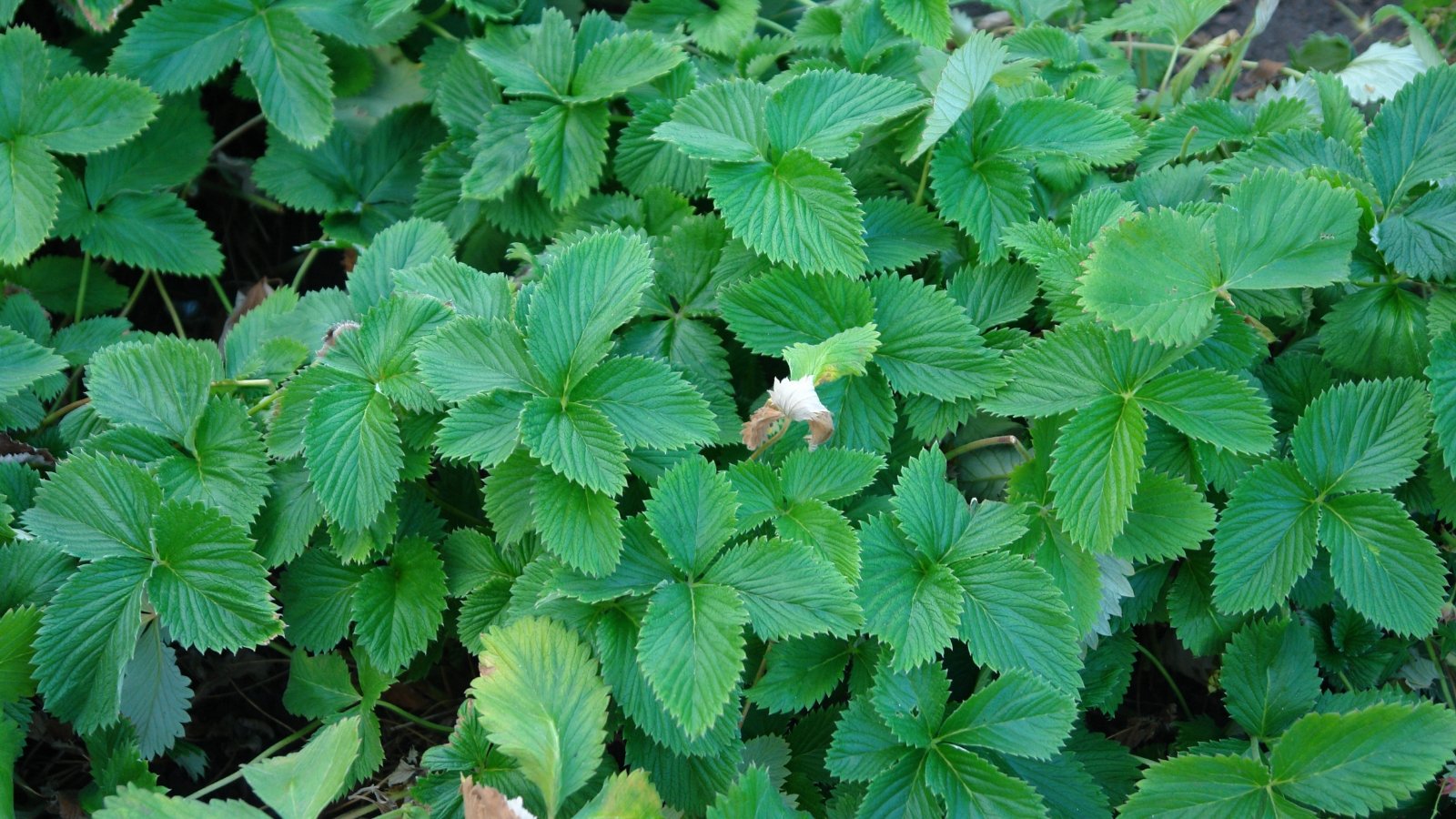
With a round, shrubby habit and blue-green leaf color, potentilla is another mid-century garden star. It offers a profusion of small, five-lobed flowers in yellow, white, orange, or pink for most of the summer.
Potentilla lends a restrained pop of color to the landscape. ‘Mount Everest’ is a solid choice for an all-white flower palette. ‘Tangerine’ will pick up earth tones from your mid-century home’s exterior.
Rhododendron
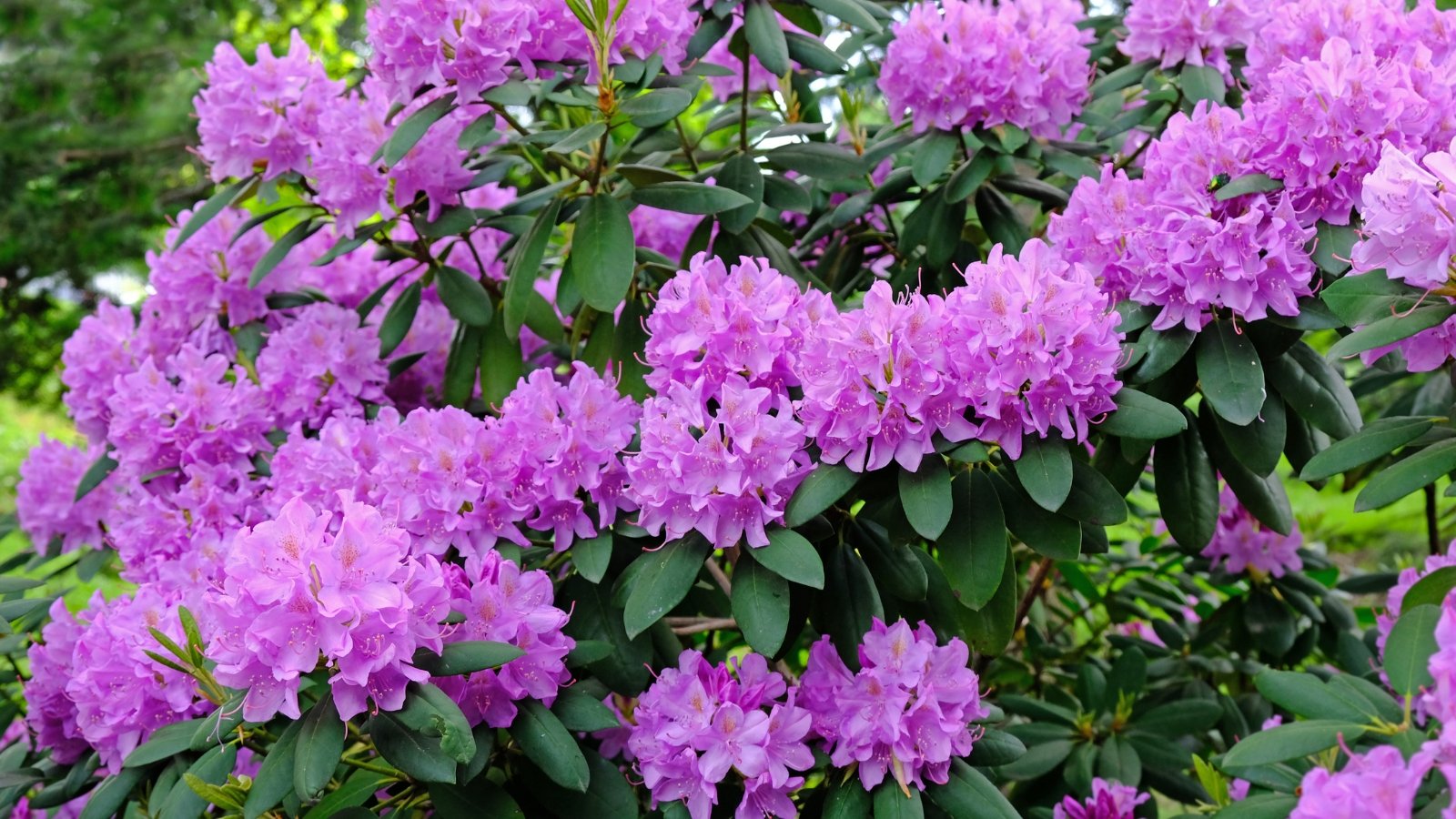
Evergreen in most climates, rhododendron shrubs have dark green, glossy leaves and a wide-spreading branch habit that lends color and structure to a mid-century modern garden design.
Flowering in early spring before many other plants have woken up, rhododendrons offer a mass of white, pink, red, or purple flowers for about three weeks, depending on the weather. ‘Girard’s Crimson’ incorporates well into a muted, primary color scheme.
Red Yucca
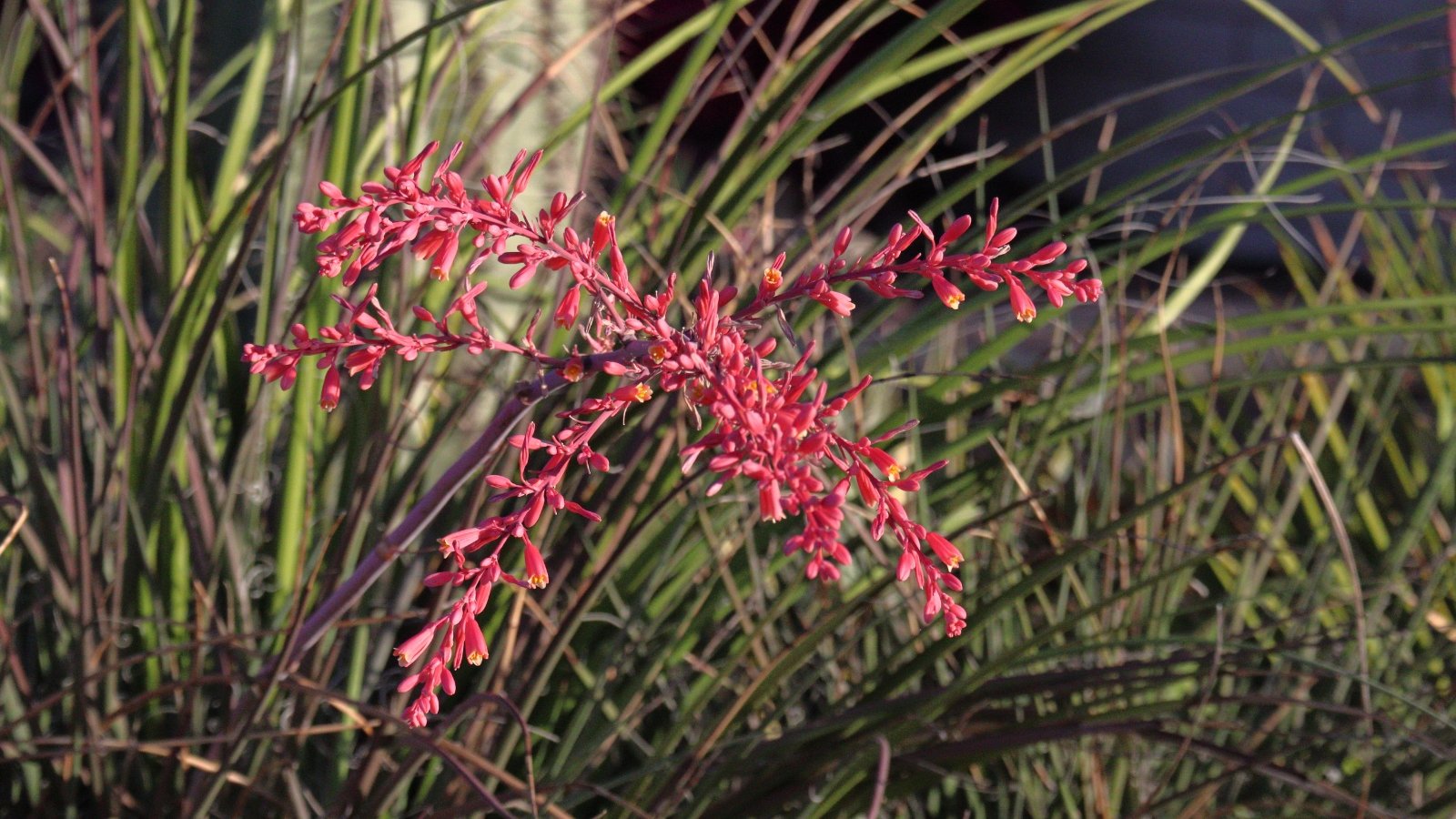
Native to the deserts of Texas and Mexico, red yucca thrives in hot, dry locations. Its blue-green leaves are the star of the show, averaging two to three feet in length and one inch in width. Fanning out from a central rosette, they hold firm and keep their shape year-round.
Perfect for a mid-century home in an arid region, yuccas send up spikes of red, yellow, or pink flowers for most of the season. Plant them in a tidy row, and they achieve the same effect as a string of boxwoods.
Nasturtium
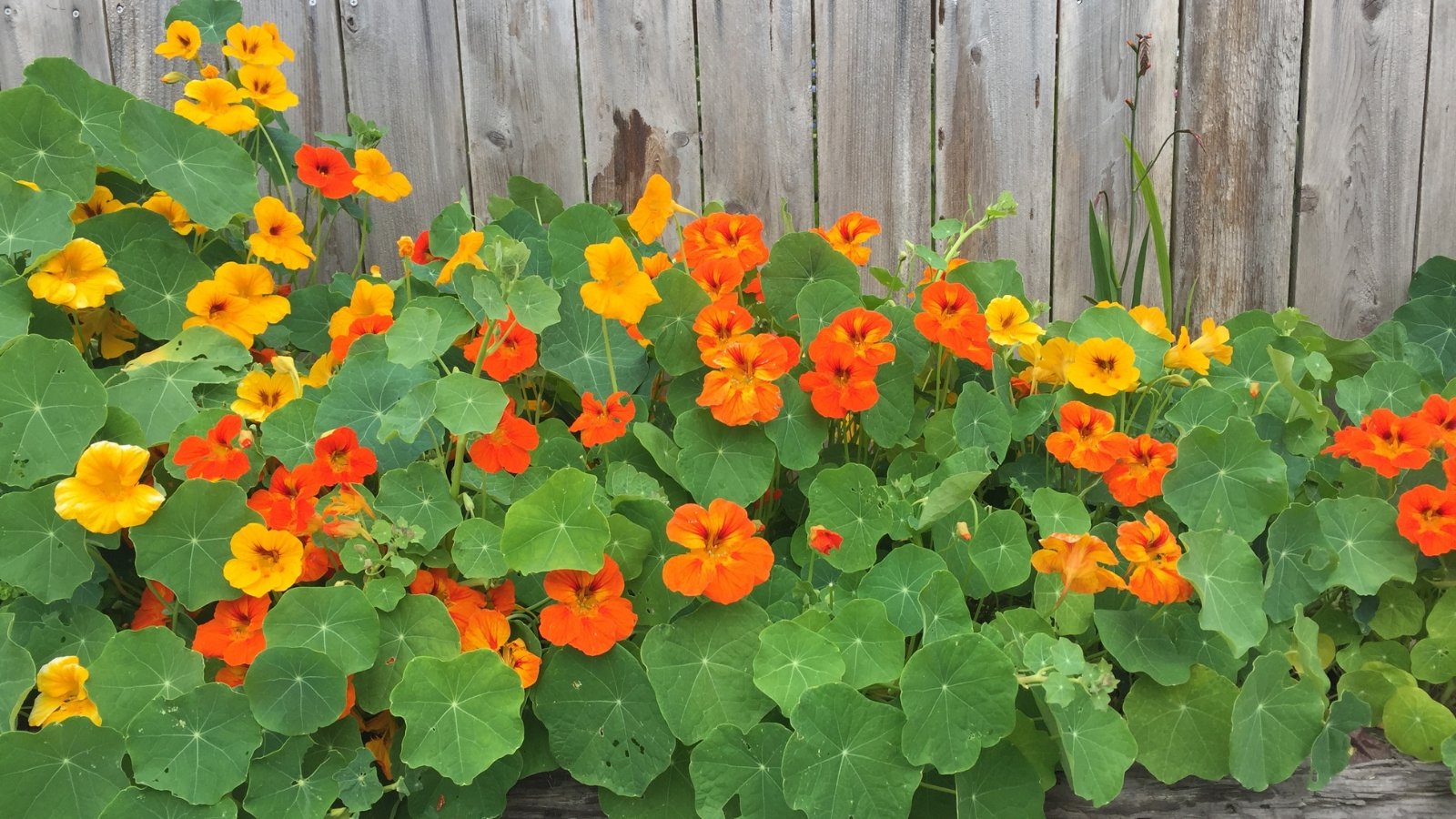
An edible plant with a peppery taste, nasturtium grows quickly from seed to fill in a large space. Its leaves, which resemble water lily or lotus flower foliage, have an octagonal shape that works with the geometry of a mid-century home garden.
Its jewel-toned flower colors (red, yellow, and orange) complement most mid-century exterior paint schemes. Plant a trailing variety like ‘Canary Creeper’ to spill over a terrace or retaining wall.
Begonia
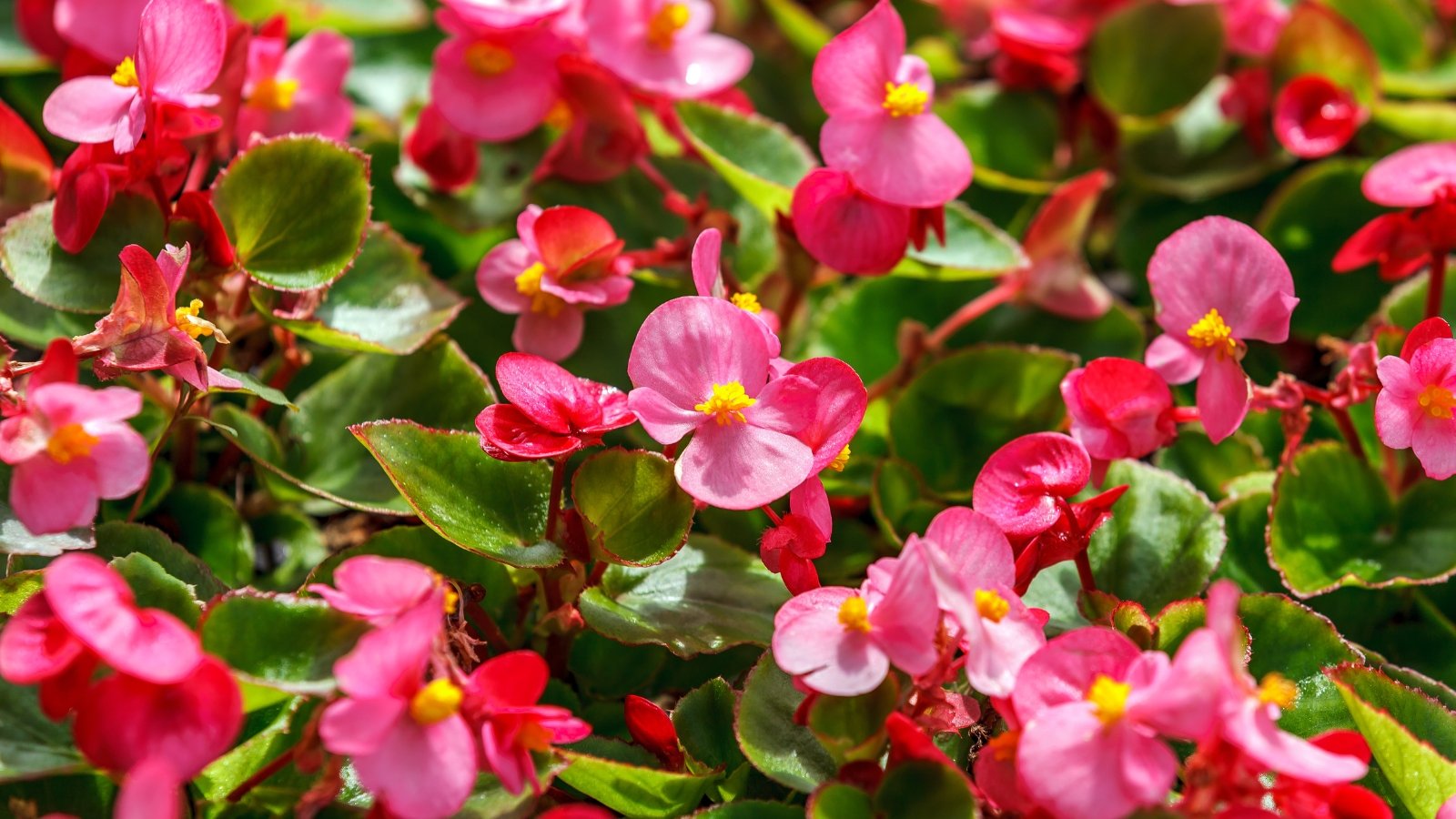
An annual in most hardiness zones, begonia has a profile that looks natural in a mid-century design. Its leaves are waxy and come in varied shades of green. Its flowers are small and simple in form, but they look beautiful when clustered together.
Plant ‘Bedding’ begonia at the feet of a pagoda dogwood, where they will be at home in the shade, or fill a low-slung terra cotta bowl with ‘Double Up White’ for a minimalist pop.
California Poppy
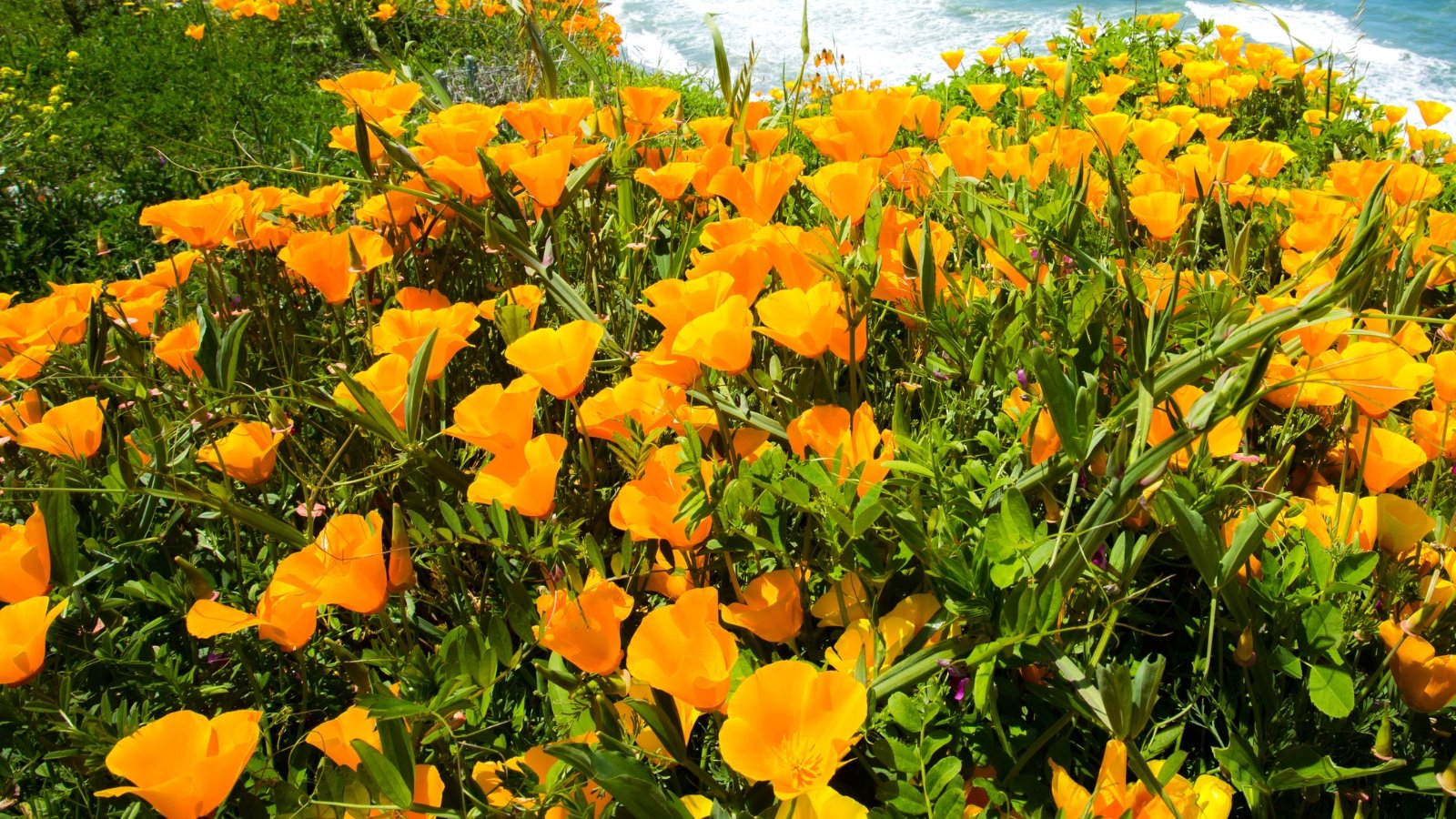
A mid-century favorite for its low-maintenance personality, earth-toned flower color, and high tolerance for drought, the California poppy lends a nice mass of color to a landscape that is otherwise mostly green.
At home amongst the yucca and oat grass, California poppy has loose, feathery foliage that mounds beneath a flower spray that persists from spring to mid-summer. ‘Golden West’ has classic, bright orange flowers with darker centers. ‘Mikado’ has darker, richer orange flowers and a little more height at 18 inches.
Agapanthus (Lily of the Nile)
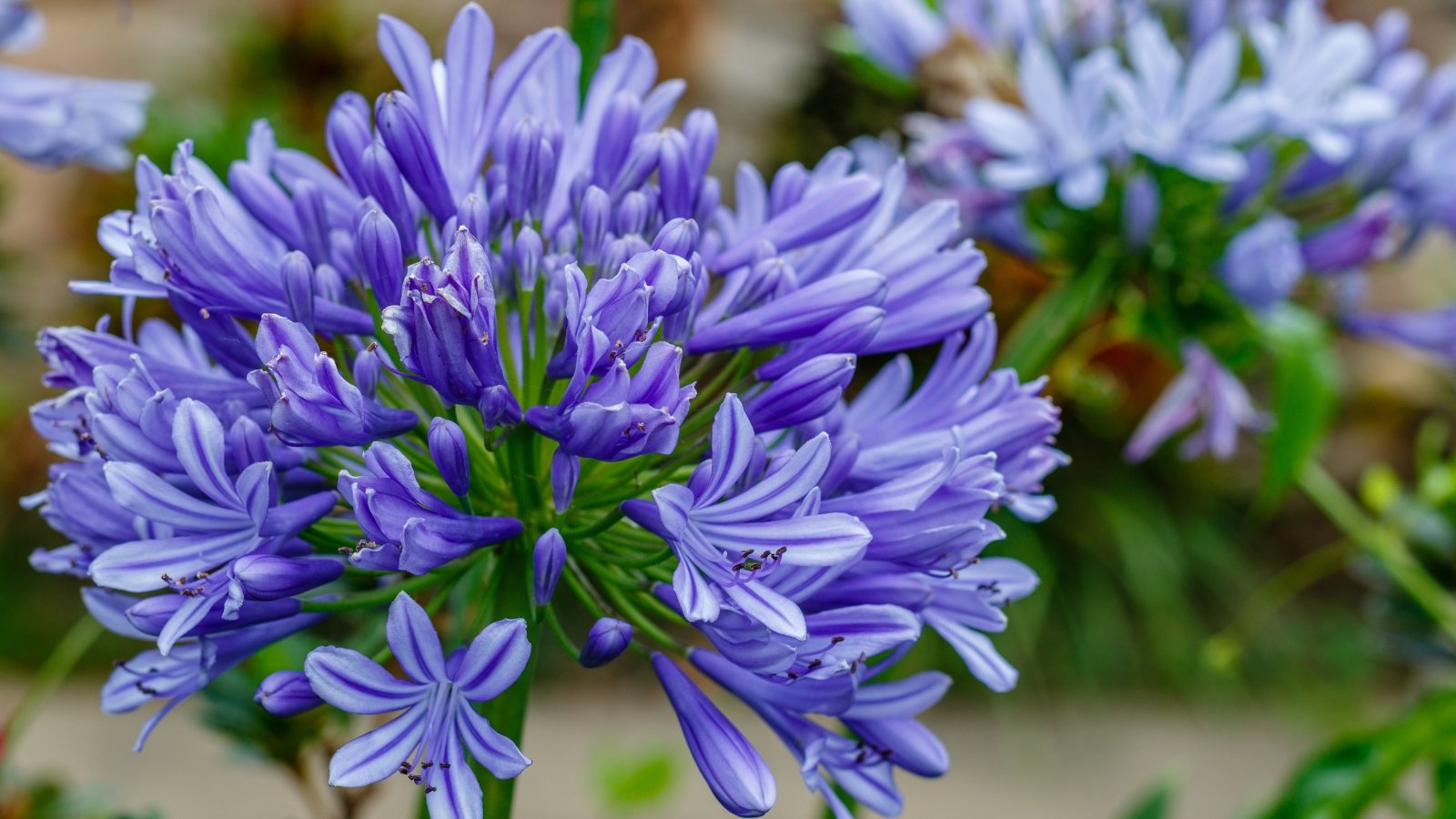
With spikes of bell-shaped blooms standing tall above a cluster of strappy green leaves, purple-flowered agapanthus pairs nicely with the reds and oranges of a traditional mid-century home exterior.
This warm-season plant requires very little fuss (another mid-century priority) and stays green all year. Plant ‘Bressingham Blue’ in a square planter, and its rhizomatous roots will expand to fill the container in just a few years.
Black-eyed Susan
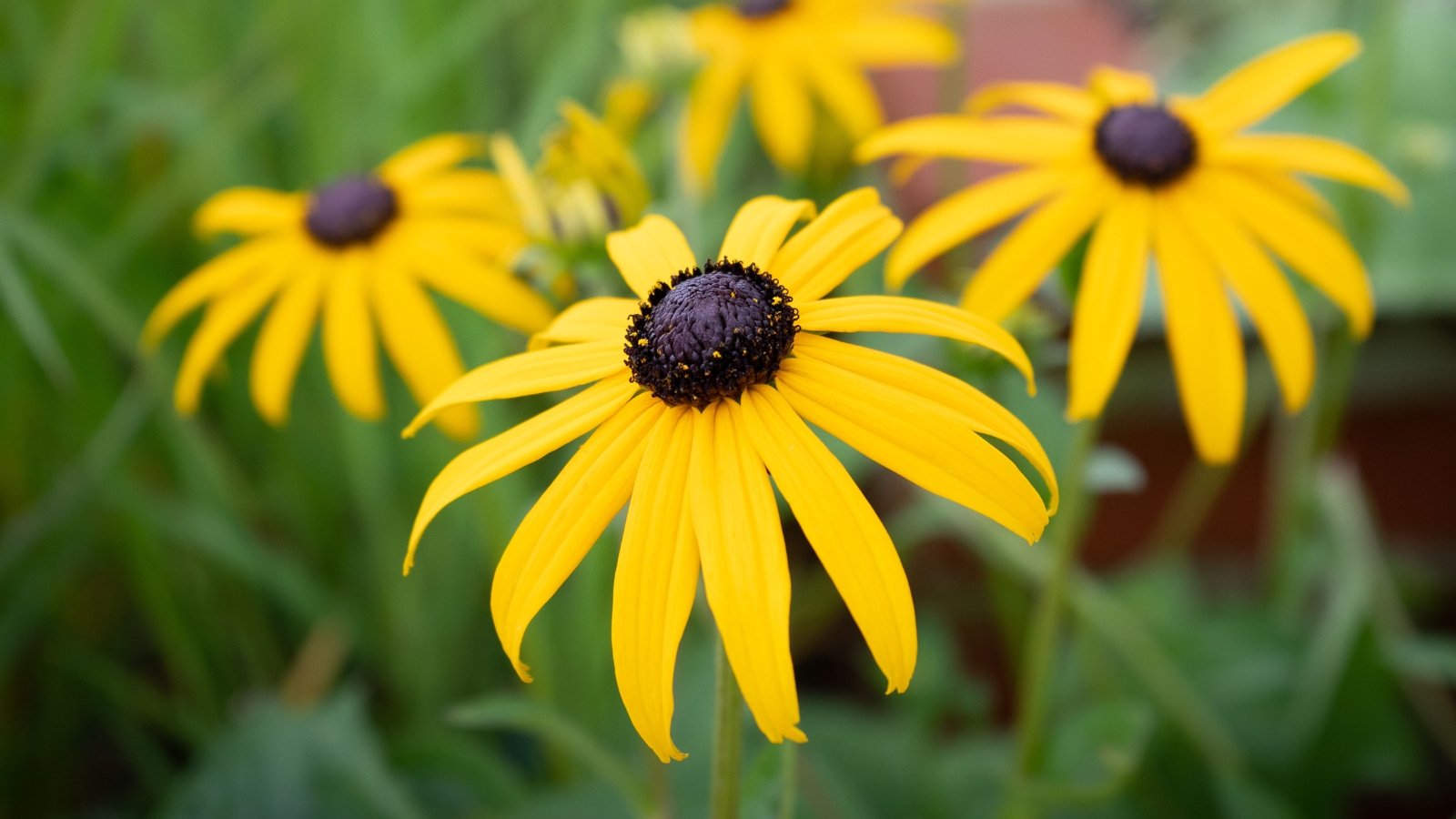
Perfect for slopes or terraces, black-eyed Susan plants lend a little prairie charm wherever they are planted. Simple in form, with disk-shaped rays of cheerful yellow or orange flowers, this herbaceous perennial requires some deadheading but is otherwise very easy to care for.
The foliage is substantial and radiates from a basal rosette. Plant a row of ‘Indian Summer’ to hit warm, mid-century notes in a linear bed. Fill a pot with ‘Maya’ for a golden marigold vibe.
Feather Reed Grass
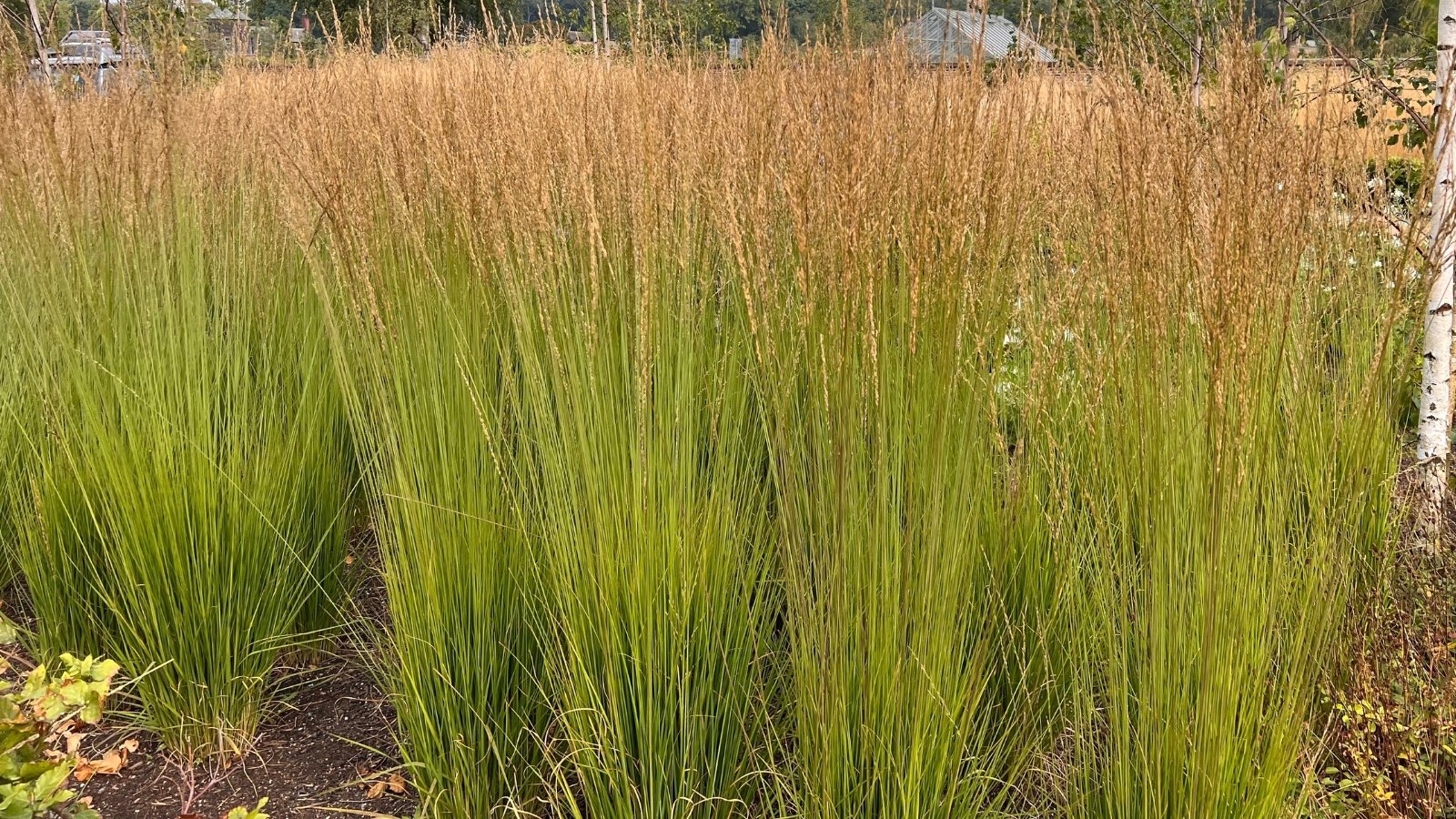
Ornamental grass is a mid-century home staple, and feather reed grass is often the top choice for landscaping professionals. Whether planted en mass to create a rectangular swath of greenery or lined up along the driveway to create a natural privacy screen, feather reed grass offers four-season interest and texture.
The leaves are tall, slender, and upright, emerging green in spring and transitioning to brown toward the end of the season. Flowers are pink and feathery, rising slightly above the foliage with subtle coloring that complements a muted overall palette.
Prairie Dropseed
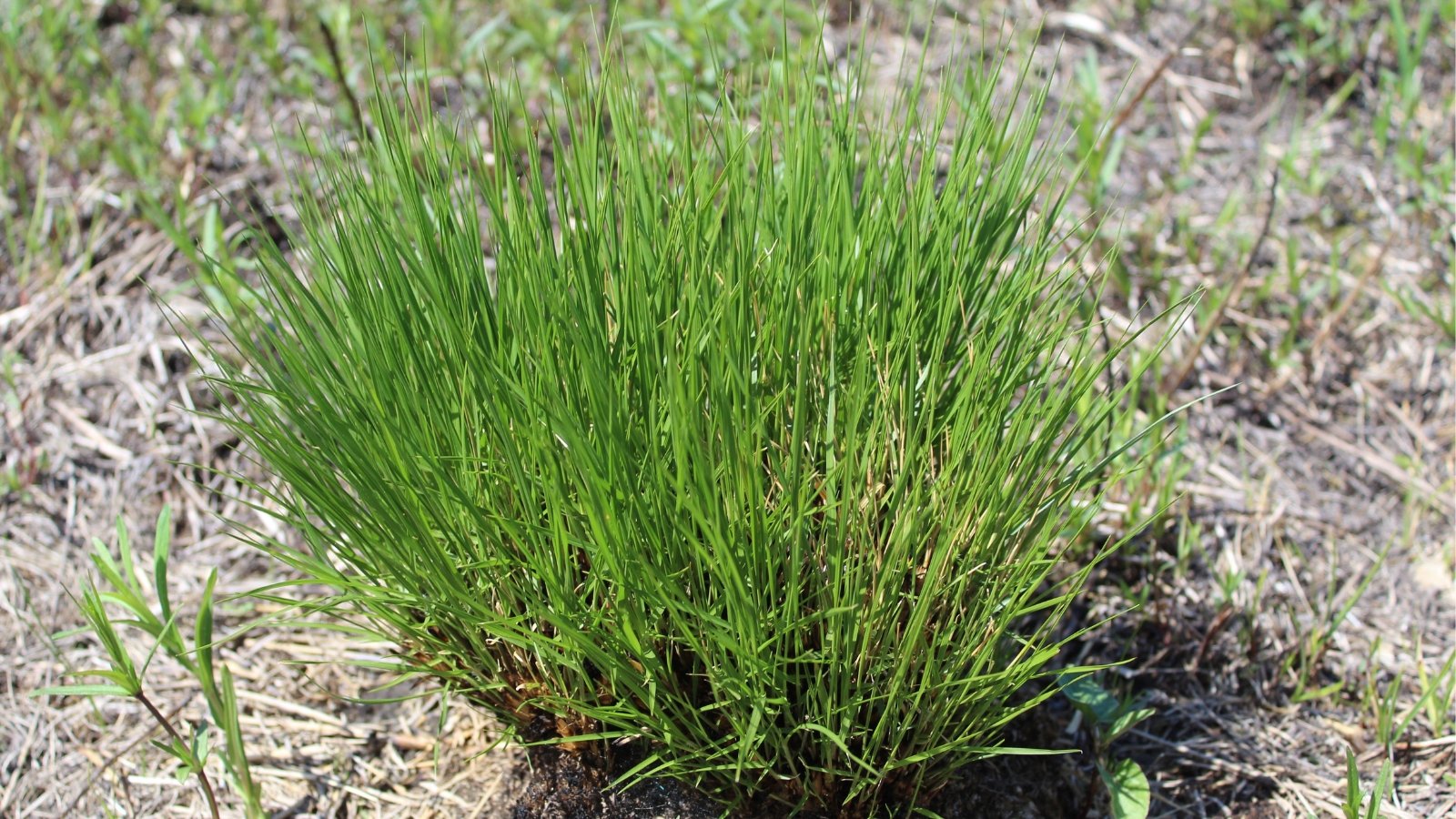
Valued for its rounded habit and low-maintenance care, prairie dropseed offers tufts of thread-like, fine-textured leaves that change from green to orange to copper as the season progresses.
Plant 20 of them in a tidy row to achieve a linear connection to your mid-century home, or plant 100 to replace traditional turf grass in a section of the front yard. Pinkish-brown flowers float above the foliage in late summer, resonating with the subdued color palette of a typical mid-century landscape.
Dwarf Mondo Grass
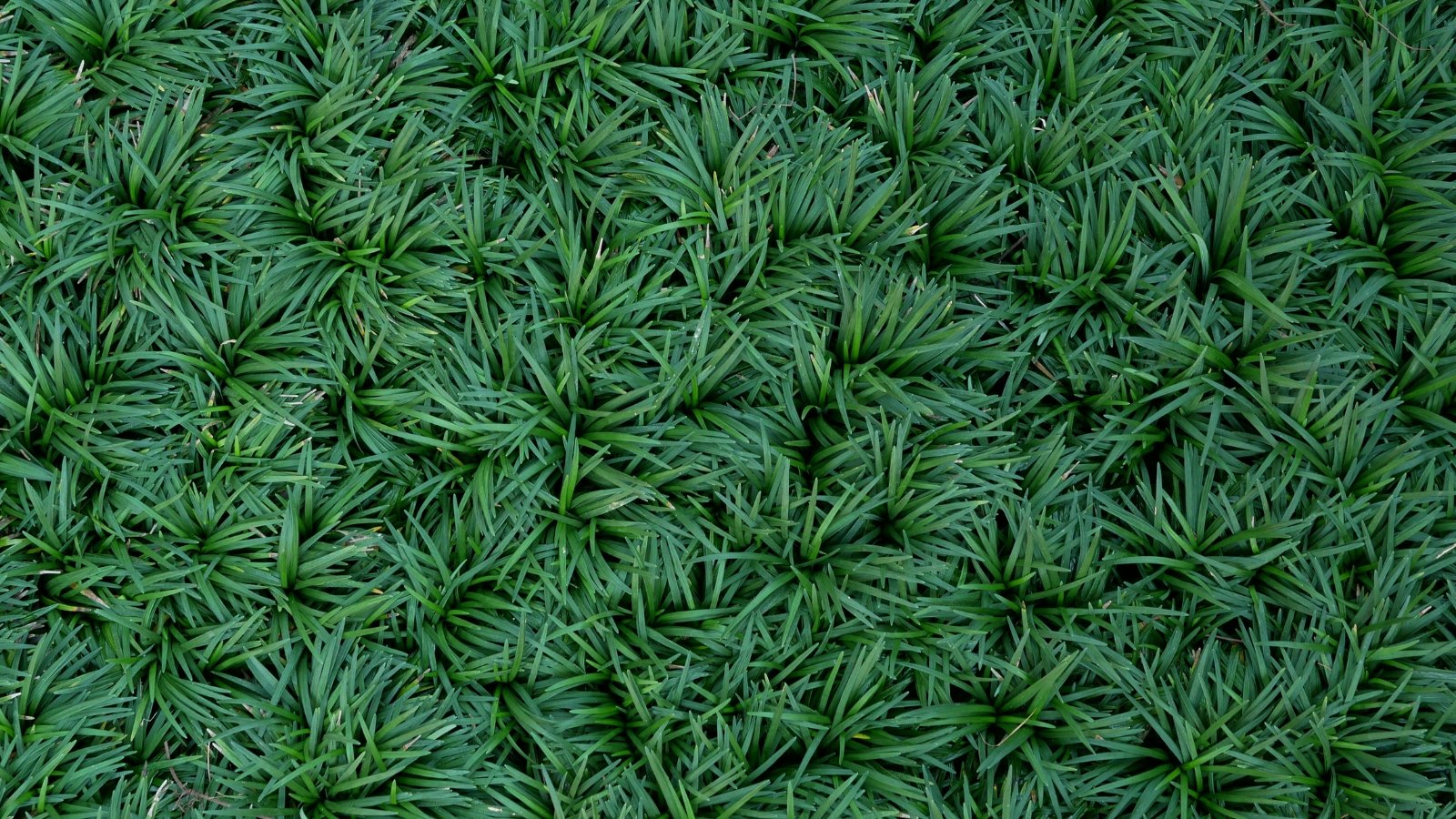
A popular choice for mid-century homeowners who request a ‘no-mow lawn,’ dwarf mondo grass provides the color, texture, and greenery of traditional grass without all the chemicals and maintenance.
Its fountain-shaped puffs of narrow foliage tolerate moderate foot traffic and heavy shade. As a bonus, it offers tiny racemes of simple white flowers in summer. Plant some in the gaps of a stone walkway or in the dappled shade of a pagoda dogwood’s broad canopy.
Pachysandra
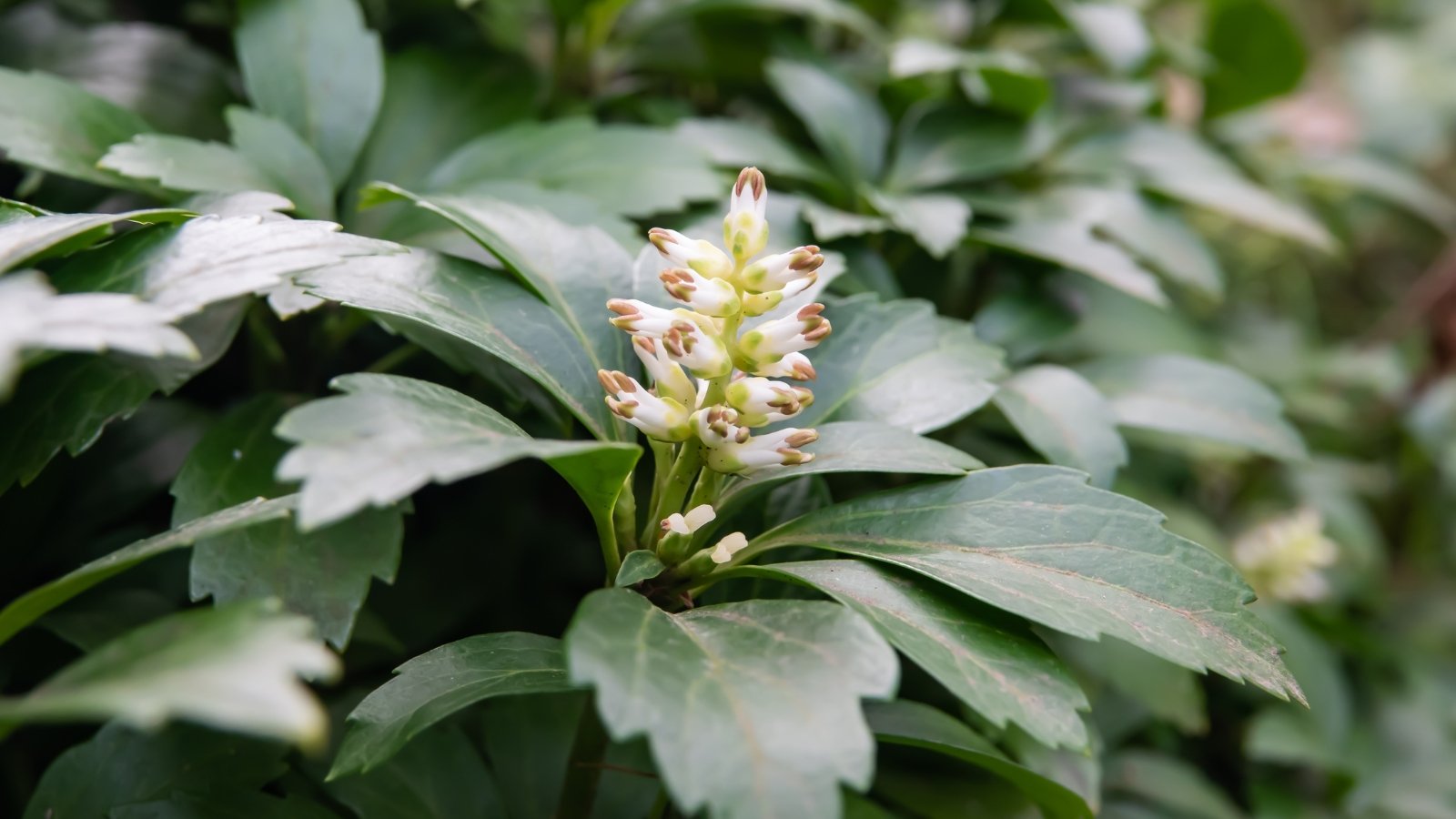
Hitting distinct Japanese garden notes that pair well with mid-century architecture, pachysandra is a semi-evergreen groundcover that spreads by rhizome to fill in a large space quickly. Primarily a foliage plant, pachysandra features whorls of leaves in multiple shades of green and small white flowers in spring.
Use it as mulch beneath an ornamental tree or to occupy segments of a shady, terraced bed. Try ‘Green Carpet’ for dark, waxy leaves and uniform growth or ‘Vairegata’ for white leaf highlights. Note that this plant is classed as an invasive species in parts of North America. Check with your extension office before planting.
Hens and Chicks
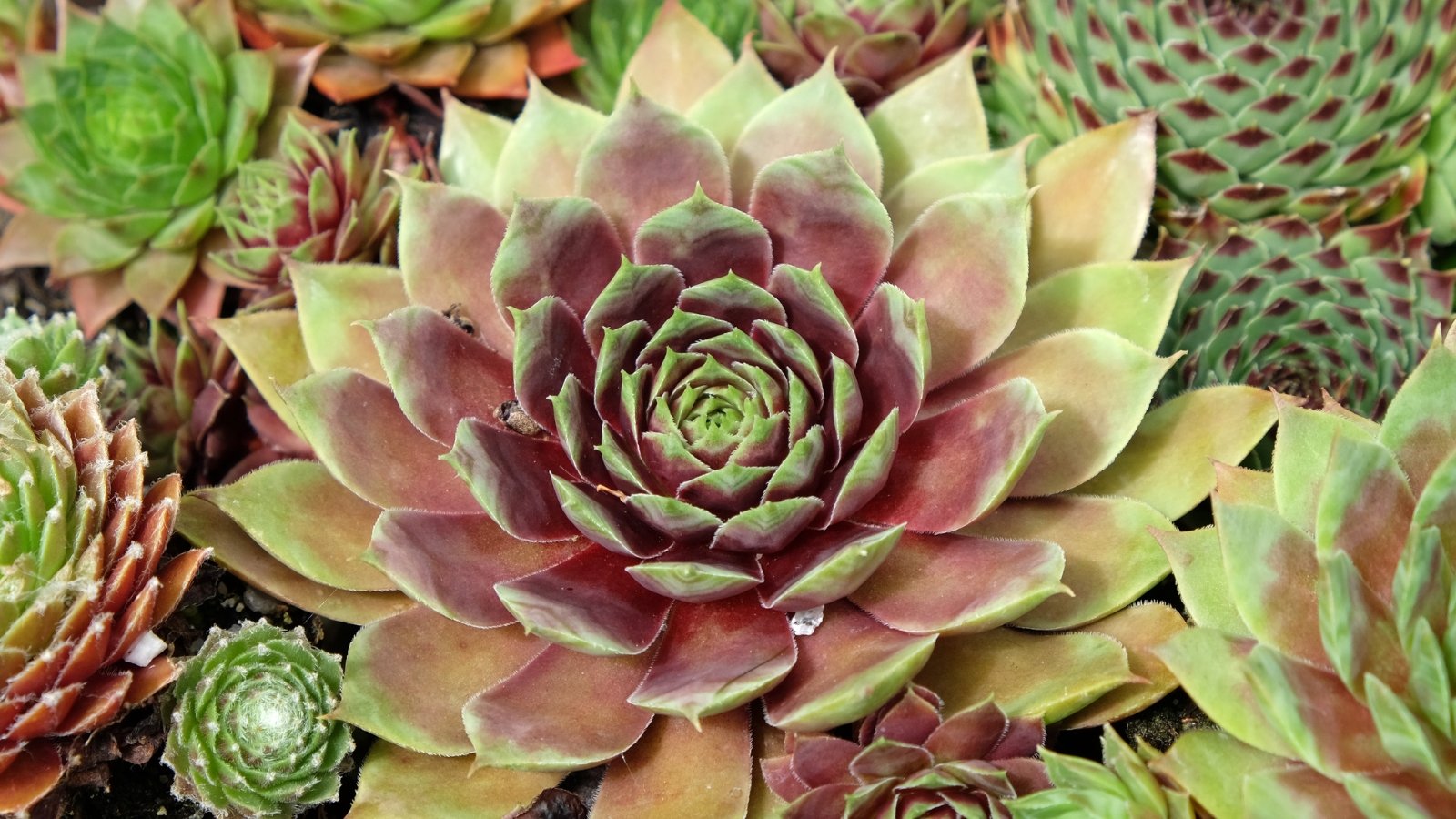
For mid-century homes in coastal or mountain regions, hens and chicks plant often plays the role of ornamental grass. This small, fleshy succulent thrives in sandy, gravely soil and enjoys full sun. It spreads easily by offshoots (the chicks) but grows relatively slowly.
The leaves are pointed and arranged in a three to four-inch rosette. They can be bronze (‘Bossieri’), red-orange (‘Sunset’), or bright green (‘Windstille’) and provide graphic texture when planted in geometric beds.
Heuchera
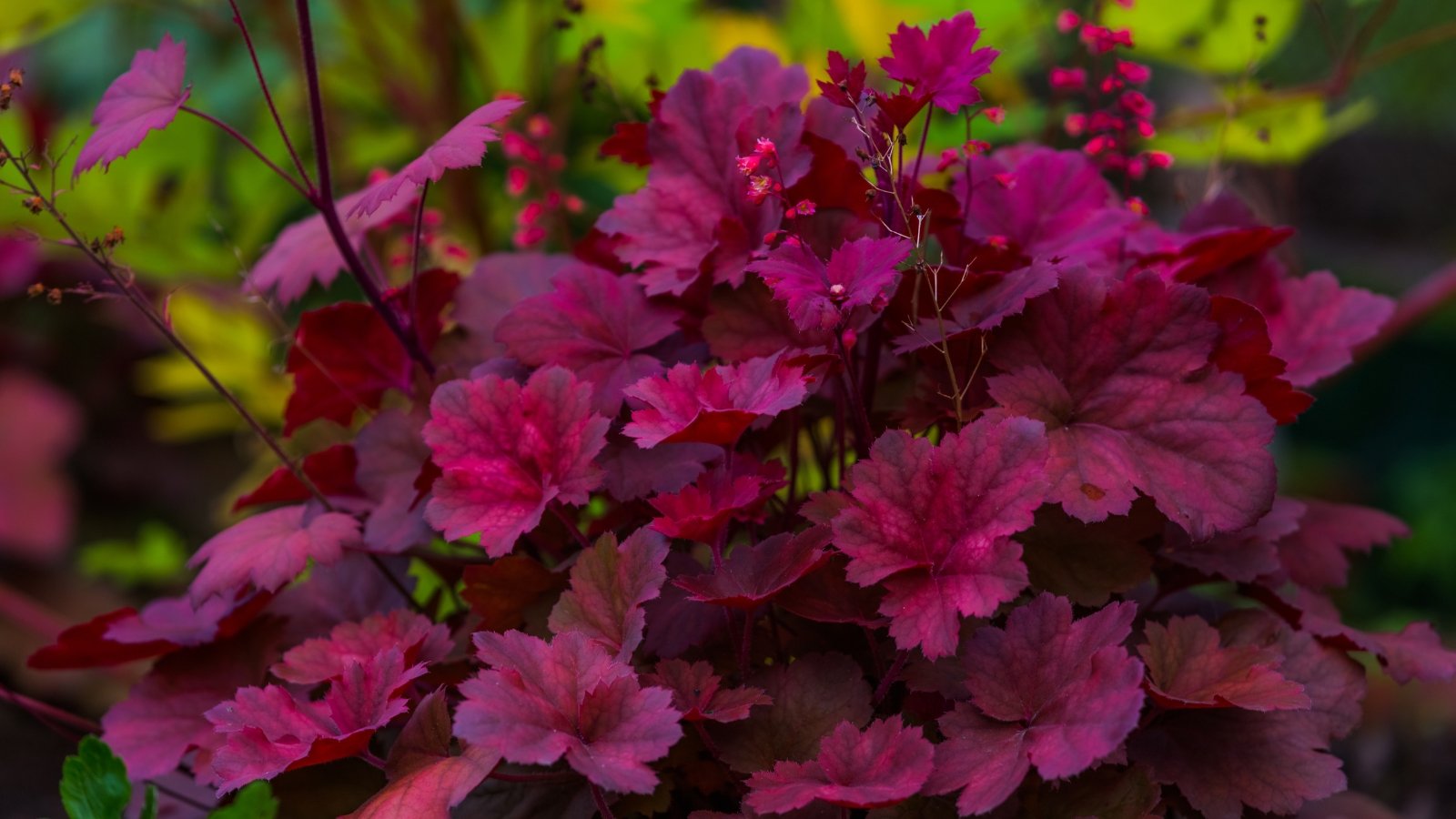
Prized for its foliage, which is large and palmately lobed, heuchera comes in shades of bronze, maroon, green, and gold that pair well with mid-century home exteriors. It’s also a very low-maintenance plant, allowing homeowners to spend their time enjoying the landscape rather than working in it.
The flowers are small and understated in color, arriving in sprays by midsummer. Plant ‘Palace Purple’ for two-toned foliage that hits olive and burgundy notes or ‘Palace Pistachio’ for a pop of bright green.
Hosta
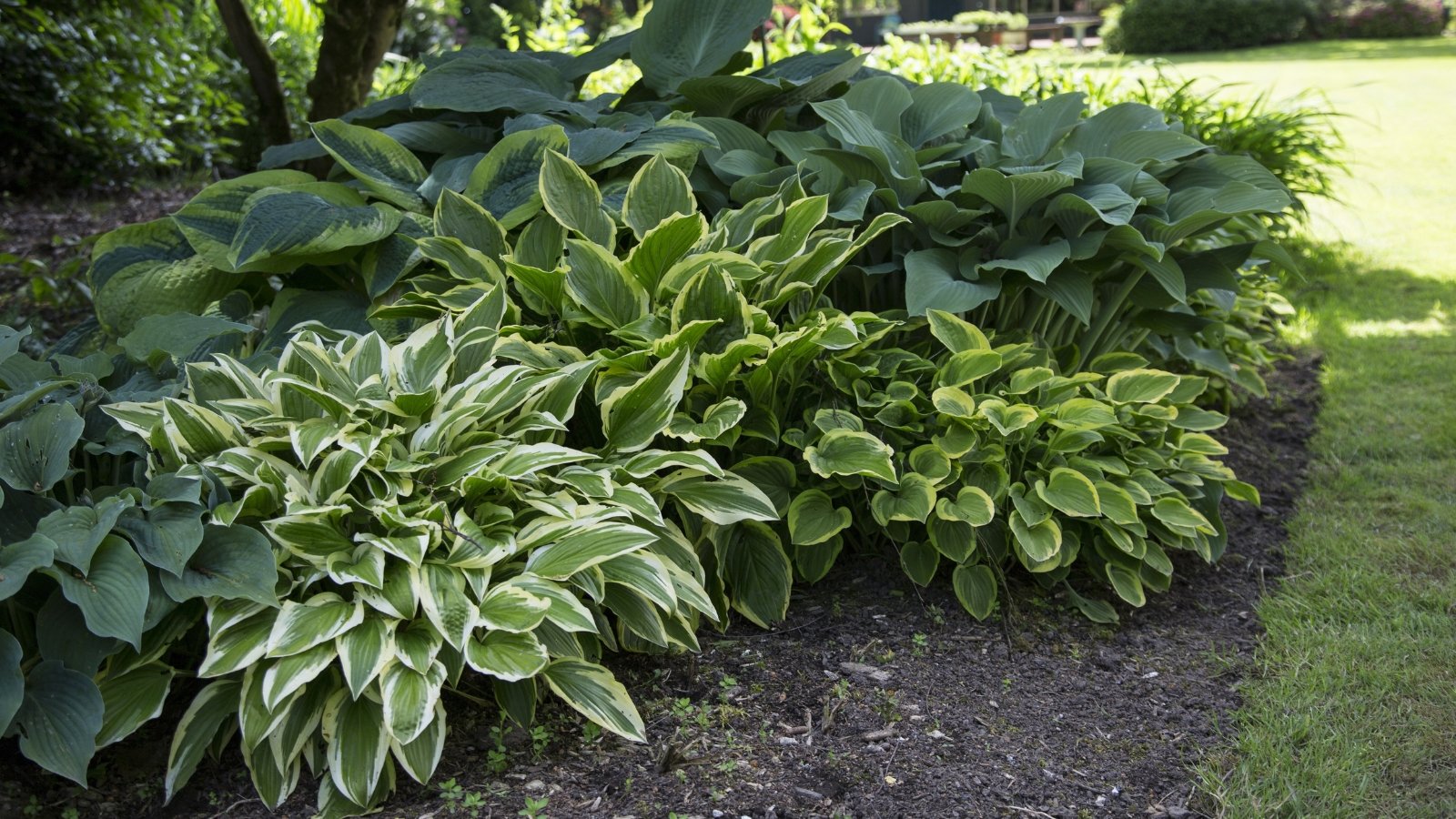
Another plant where the foliage is the star, hosta tolerates shade and fills in nicely at the feet of other plants. With large fleshy leaves that are ovate to oblong in shape, hosta grows in a neat clump that resonates with other orb-shaped plants in the mid-century garden.
Tall sprays of insignificant flowers add a bit of color without demanding too much attention in summer. Try ‘Blue Mouse Ears’ for a small-scale patio edging or 3-foot, bright green ‘Sum and Substance’ for a shrub-like effect.
Japanese Painted Fern
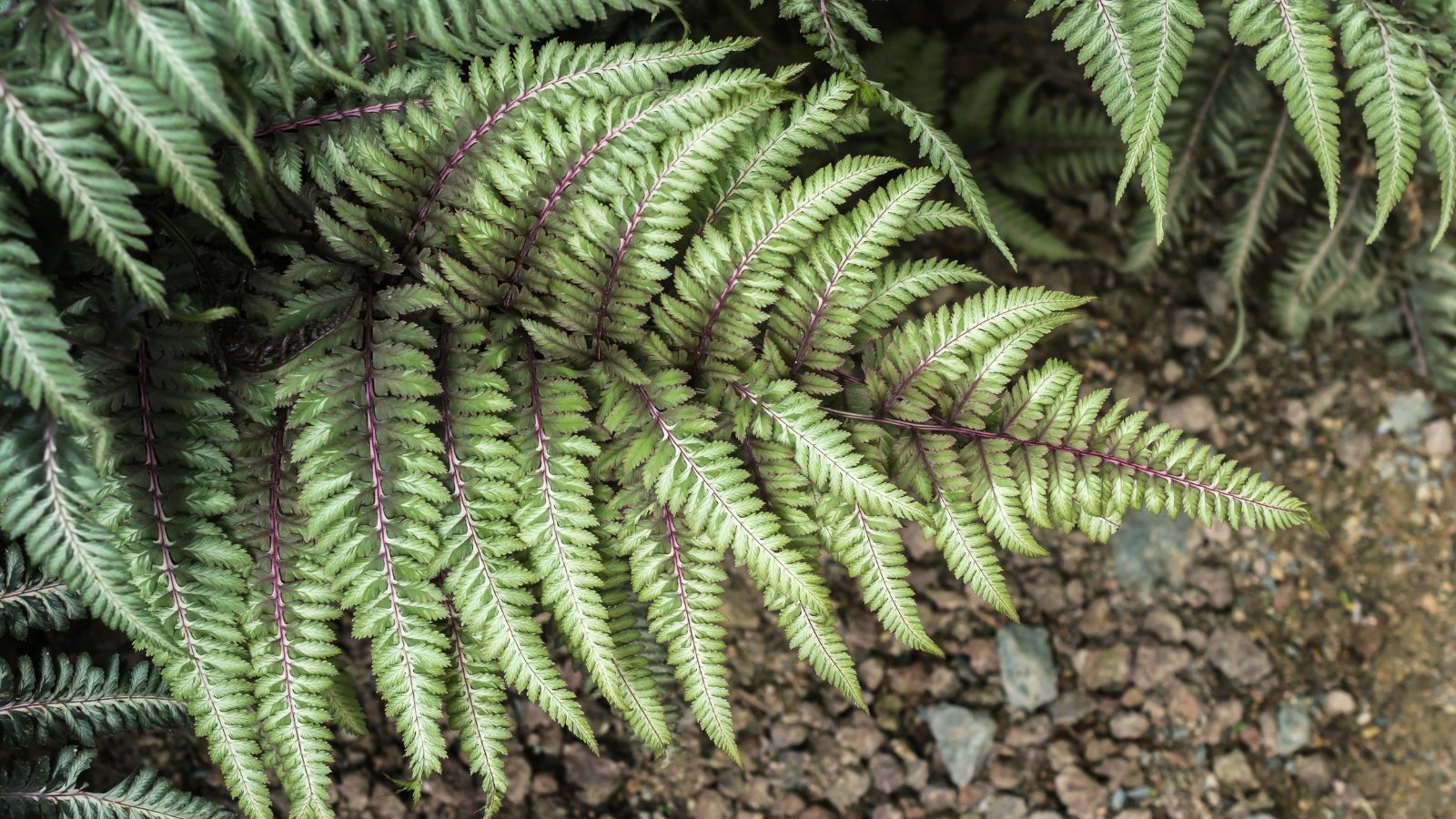
Japanese painted ferns feature 20-inch triangular fronds in shades of maroon, green, gray, and silver. They pair well with the earthy color scheme of a mid-century modern home. Perfect for beds with northern exposure or dappled shade,
Japanese fern offers texture and personality without stealing the show. It requires very little attention and has no significant issues with insects or disease. ‘Godzilla’ has dusty green leaves and purple midribs, while ‘Pictum’ offers shades of silver and red.
Final Thoughts
Simplicity, geometry, repetition, and restraint are the cornerstones of mid-century modern gardening. Think of your landscape as an extension of the home and divide it into zones for leisure, function, privacy, etc.
Make sure the views from your home are enjoyable and harmonize with the land surrounding it. No single plant should hog the spotlight or consume too much of your free time with its care. Keep these principles in mind, and you’ll be well on your way to a mid-century garden that looks natural and feels right for your home.




